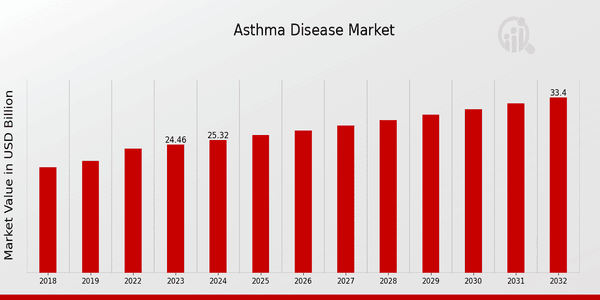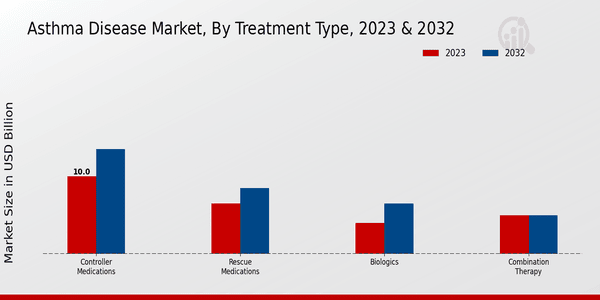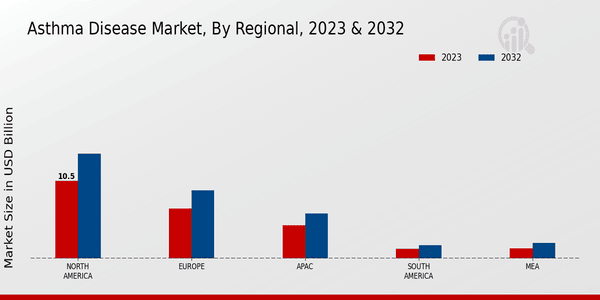Global Asthma Disease Market Overview
As per MRFR analysis, the Asthma Disease Market Size was estimated at 26.22 (USD Billion) in 2024. The Asthma Disease Market Industry is expected to grow from 27.14 (USD Billion) in 2025 to 37.06 (USD Billion) till 2034, at a CAGR (growth rate) is expected to be around 3.52% during the forecast period (2025 - 2034).
Key Asthma Disease Market Trends Highlighted
The Asthma Disease Market is influenced by several key market drivers that contribute to its growth. Increasing prevalence of asthma, driven by factors such as urbanization, pollution, and changing lifestyle patterns, plays a significant role in expanding the market. Awareness campaigns focusing on prevention and management of asthma also significantly contribute to the demand for effective treatment options. Additionally, advancements in healthcare technology and the development of new medications and inhalation devices enhance the treatment landscape, providing patients with more effective management solutions. Opportunities abound in the market, particularly in the areas of personalized medicine and telehealth services.
he rise of digital health solutions presents a chance for companies to create innovative treatments and management tools tailored to individual patient needs. Furthermore, there is potential for growth in emerging economies where access to healthcare services is expanding. Developing new formulations and delivery methods can also capture interest in regions with unmet medical needs, thus marking significant opportunities for investment and innovation. In recent times, trends have shown a shift towards preventive care and an emphasis on patient education to improve disease management.
The integration of artificial intelligence and data analytics into asthma management platforms is becoming increasingly important, allowing for better tracking of patient symptoms and adherence to treatment plans.There is also a growing interest in biological therapies that target specific inflammation pathways in asthma, offering alternatives to traditional medications. This evolution in treatment options reflects a broader understanding of asthma and demonstrates a trend towards more customized and effective approaches in managing the disease, ultimately improving patient outcomes.

Source: Primary Research, Secondary Research, MRFR Database and Analyst Review
Asthma Disease Market Drivers
Increasing Prevalence of Asthma
The rising prevalence of asthma globally is a critical driver for the Asthma Disease Market Industry. With urbanization and changes in lifestyle leading to higher rates of respiratory diseases, healthcare systems are increasingly focusing on asthma management. The increased diagnosis and awareness of asthma conditions have resulted in larger patient populations requiring ongoing treatment. This growing patient base is pushing significant advancements in therapeutic solutions and management strategies, which is incredibly beneficial for market stakeholders.
Furthermore, the aging population is more susceptible to chronic respiratory diseases, including asthma, contributing to a higher overall market demand. As the market is expected to be valued significantly higher in the future, it reflects the urgency to address asthma with effective treatment options. Innovations in medication and treatment protocols are increasingly critical in this market. Many pharmaceutical companies are exploring new therapeutic alternatives and delivery methods to enhance the quality of life for patients.Researchers are developing targeted therapies and preventive measures that address not only the symptoms but also the underlying causes of asthma. As clinicians become more knowledgeable about asthma management, it leads to better patient outcomes and aids in market growth.
The increased emphasis on personalized medicine also enhances treatment efficacy, making it easier for patients to adhere to their prescribed therapies. In the long term, the continuous evaluation of asthma management guidelines will shape the landscape of the Asthma Disease Market Industry, contributing to novel interventions and improved health systems.
Advancements in Treatment Options
One of the significant drivers in the Asthma Disease Market Industry is the rapid advancement in treatment options for asthma. Innovative therapies such as biologics have emerged, offering targeted treatment strategies that provide more effective control of asthma symptoms. These advancements not only enhance treatment efficacy but also improve patient adherence to therapy regimens, thus supporting long-term market growth. As more research is focused on understanding the pathophysiology of asthma, new drugs and therapies are being developed that target specific pathways involved in the condition.This exploration and subsequent development of more potent combinations and customized asthma medications have a profound impact on patient outcomes.
Growing Awareness and Education
Increased awareness and education about asthma management play vital roles in driving the Asthma Disease Market Industry.
As public health campaigns advocate for a better understanding of asthma, individuals are becoming more familiar with the symptoms and the importance of proper management strategies. This heightened awareness leads to earlier diagnosis and treatment, which is crucial for optimal management of asthma. Educational initiatives targeting both patients and healthcare professionals contribute to improved knowledge, ultimately resulting in better health outcomes and a growing market.
Asthma Disease Market Segment Insights:
Asthma Disease Market Treatment Type Insights
The Asthma Disease Market is characterized by various treatment types, which play a crucial role in managing asthma symptoms and improving patients' quality of life. In 2023, the market's total revenue reached 24.46 USD Billion, with expectations to grow to 33.4 USD Billion by 2032, reflecting steady development in treatment methodologies.
Within this dynamic landscape, Controller Medications emerge as a dominant force, valued at 10.0 USD Billion in 2023 and projected to climb to 13.5 USD Billion in 2032. This segment holds majority significance as it focuses on long-term management and prevention of asthma attacks, making it essential for patients who need to maintain control over their condition.
On the other hand, Rescue Medications also play an important role in the asthma treatment landscape, recording a valuation of 6.5 USD Billion in 2023, with an increase to 8.5 USD Billion anticipated by 2032. These medications are critical for patients experiencing acute asthma symptoms, providing rapid relief and underscoring the importance of immediate intervention during attacks.
Biologics, valued at 4.0 USD Billion in 2023, are gaining traction as innovative therapies that target specific pathways involved in asthma, projecting a valuation of 6.5 USD Billion by 2032. This growing sub-segment offers tailored treatment options and presents a significant leap in managing severe asthma cases.
Moreover, Combination Therapy, valued at 4.96 USD Billion in 2023 and expected to rise modestly to 5.0 USD Billion by 2032, integrates multiple mechanisms of action to provide comprehensive management of asthma, catering to patients with complex needs. It is vital for optimizing treatment effectiveness and minimizing side effects, thereby enhancing patient compliance.
The Asthma Disease Market segmentation showcases diverse treatment types that not only accommodate different patient requirements but also reflect ongoing advancements in asthma management strategies. The growth of these segments is driven by increasing asthma prevalence, heightened awareness of available treatments, and ongoing innovations in drug formulations and delivery methods.
However, challenges persist, including the need for enhanced patient education, accessibility to treatments, and addressing the high cost of advanced therapies such as biologics. Overall, the interplay between these treatment types not only shapes the current market landscape but also identifies future opportunities for growth and improvement within the Global Asthma Disease Market.

Source: Primary Research, Secondary Research, MRFR Database and Analyst Review
Asthma Disease Market Cause of Asthma Insights
The Asthma Disease Market is currently valued at 24.46 billion USD in 2023 and is witnessing a steady growth trajectory driven by various factors, including rising pollution and increasing prevalence of allergens. The market shows a diverse segmentation around the cause of asthma, prominently featuring Allergic Asthma, Non-Allergic Asthma, Exercise-Induced Asthma, and Occupational Asthma. Allergic Asthma is notable for being one of the most common forms triggered by airborne substances such as pollen and dust. Non-allergic asthma, while less common, significantly contributes to the market landscape as respiratory infections, stress, or physical activities cause it.Exercise-induced asthma typically impacts individuals during physical exertion, making it an essential area of focus for athletic populations. Occupational Asthma emerges from workplace irritants, highlighting the need for specific preventive and therapeutic measures in various industries.
Understanding these causes and their prevalence provides critical insights into the Asthma Disease Market data, showcasing the necessity for targeted treatments and market growth potential in addressing the specific needs of asthma sufferers.
Asthma Disease Market Severity Insights
The Global Asthma Disease Market, with a valuation of 24.46 billion USD in 2023, has shown notable segmentation in terms of severity, highlighting its essential role in understanding treatment approaches and patient management strategies. The severity of asthma can be categorized into various classifications, with Mild Intermittent and Mild Persistent presenting a considerable portion of the overall patient population, indicating a significant need for effective management solutions in these areas.
Moderate Persistent asthma accounts for a substantial share as well, reflecting a critical segment requiring sustained treatment to maintain control and minimize exacerbations.Severe Persistent asthma dominates the severity landscape due to its higher healthcare resource consumption and complexity in management, necessitating advanced therapies and personalized treatment plans.
The Asthma Disease Market statistics suggest that changes in lifestyle, environmental factors, and urbanization trends continue to drive the prevalence of asthma, further emphasizing the market's growth potential. Therefore, understanding the Asthma Disease Market segmentation around severity aids in addressing individual patient needs and tailoring innovations effectively to manage asthma in various severity levels.The trends in healthcare spending and increased awareness about asthma management are expected to catalyze market growth in the coming years.
Asthma Disease Market Age Group Insights
The Asthma Disease Market revenue is significantly influenced by the age group segmentation, which encompasses Children, Adolescents, Adults, and the Elderly. In 2023, the market is valued at 24.46 USD Billion, showcasing substantial importance across various age demographics.
Each age group presents different challenges and treatment approaches, ultimately driving market growth. For instance, the Children and Adolescents segments are crucial because of the rising incidence of asthma among young individuals, emphasizing the need for tailored management solutions.Adults constitute a major portion of the Asthma Disease Market statistics, reflecting an increased awareness and diagnosis of asthma, while the Elderly group adds complexity due to comorbidities, necessitating specialized treatments. The increasing prevalence of asthma, along with advancements in inhalation therapy and patient education, are notable growth drivers for this market.
However, challenges such as environmental factors and adherence to therapies persist, requiring constant innovation and strategic planning within the Asthma Disease Market industry to meet diverse needs across all age groups.The Asthma Disease Market data indicates that addressing these factors is pivotal to sustaining market development and ensuring effective asthma management for all age demographics.
Asthma Disease Market Regional Insights
The Asthma Disease Market achieved a valuation of 24.46 USD Billion in 2023, with notable contributions from various regions. North America held a majority share, valued at 10.5 USD Billion, and is expected to grow to 14.2 USD Billion by 2032, driven by advanced healthcare infrastructure and rising asthma prevalence.
Europe followed with a significant valuation of 6.8 USD Billion in 2023, growing to 9.2 USD Billion, reflecting increased awareness and treatment adoption. The APAC region, valued at 4.5 USD Billion in 2023, is set to reach 6.1 USD Billion, bolstered by growing populations and rising healthcare expenditure.Meanwhile, South America and MEA showcase smaller but important markets, valued at 1.3 USD Billion and 1.36 USD Billion, respectively, in 2023. Their growth potential stems from improving healthcare access and increasing the prevalence of asthma. Across these regions, the Asthma Disease Market revenue trends indicate a continued focus on innovation in treatment and management, as well as addressing environmental factors contributing to asthma.

Source: Primary Research, Secondary Research, MRFR Database and Analyst Review
Asthma Disease Market Key Players and Competitive Insights:
The Asthma Disease Market is characterized by a diverse and competitive landscape where numerous pharmaceutical and biotechnology companies are striving to innovate and deliver effective treatment options. This sector is increasingly driven by a rise in asthma prevalence, advancements in treatment protocols, and greater awareness among patients and healthcare providers regarding asthma management.
The competitive insights reveal that companies are focusing on developing biologics, incremental advancements in inhaler technology, and personalized medicine to cater to the varying needs of asthma patients. As competition intensifies, firms are enhancing their research and development efforts to offer targeted therapies designed specifically for different asthma phenotypes while also grappling with the complexities of regulatory approvals and market access challenges.AstraZeneca has emerged as a formidable player in the Global Asthma Disease Market, leveraging its extensive portfolio of respirable therapies and biologics.
The company has positioned itself as a leader through its strategic investments in research and development, yielding groundbreaking treatments that address both mild and severe asthma. One of the defining strengths of AstraZeneca is its commitment to innovative delivery systems, which include advanced inhalers that improve medication adherence and patient outcomes. Furthermore, the company has established robust collaborations with research institutions and healthcare systems to enhance patient education and disease management. AstraZeneca's strong presence in both developed and emerging markets further solidifies its competitive edge, as it provides diversified access to its therapies, ensuring that more patients benefit from its leading treatment options.
Sanofi is another key competitor within the Global Asthma Disease Market, recognized for its comprehensive approach to addressing asthma through a broad range of products. The company's strengths lie in its well-established presence in the biologics segment, demonstrating efficacy in treating severe asthma. Sanofi emphasizes patient-centric solutions by integrating patient support programs that enhance medication adherence and foster better disease management practices. Furthermore, the company boasts a strong pipeline of innovative drugs, including various monoclonal antibodies targeting specific asthma pathways, which positions it well to meet the evolving treatment demands. Sanofi's collaborative efforts with healthcare professionals and patient advocacy groups further amplify its reach in the market, enabling the company to understand better and respond to patient needs while enhancing its competitive position in the asthma therapeutic landscape.
Key Companies in the Asthma Disease Market Include:
- AstraZeneca
- Sanofi
- Merck and Co
- Eli Lilly and Company
- Teva Pharmaceutical Industries
- Boehringer Ingelheim
- Mylan
- Bristol-Myers Squibb
- Pfizer
- Johnson and Johnson
- Roche
- Novartis
- Amgen
- GlaxoSmithKline
Asthma Disease Market Industry Developments
The Asthma Disease Market has seen several recent developments impacting major companies and their market strategies. AstraZeneca has made strides in advancing its asthma treatments, particularly the use of biologics, which could enhance patient outcomes significantly. Sanofi has also been working on innovative therapies that may reshape asthma management. Merck & Co. is actively engaged in research to expand its portfolio, while Eli Lilly and Company are focusing on allergy-related asthma treatments. Teva Pharmaceutical Industries is enhancing accessibility to its medications, and Boehringer Ingelheim continues to broaden its range of respiratory products.
There have been discussions regarding the merger activities within this sector, with notable attention on potential collaborations that can leverage shared technologies or customer bases, primarily involving companies like Pfizer and Johnson & Johnson. Current market valuations suggest a growth trajectory as competition intensifies and R&D investment increases, particularly among companies like Roche, Novartis, and GlaxoSmithKline. This dynamic environment reflects an increasing emphasis on personalized medicine and enhanced therapeutic options, which are pivotal in meeting the evolving needs of asthma patients globally.
Asthma Disease Market Segmentation Insights
- Asthma Disease Market Treatment Type Outlook
- Controller Medications
- Rescue Medications
- Biologics
- Combination Therapy
- Asthma Disease Market Cause of Asthma Outlook
- Allergic Asthma
- Non-Allergic Asthma
- Exercise-Induced Asthma
- Occupational Asthma
- Asthma Disease Market Severity Outlook
- Mild Intermittent
- Mild Persistent
- Moderate Persistent
- Severe Persistent
- Asthma Disease Market Age Group Outlook
- Children
- Adolescents
- Adults
- Elderly
- Asthma Disease Market Regional Outlook
- North America
- Europe
- South America
- Asia-Pacific
- Middle East and Africa
| Report Attribute/Metric |
Details |
|
Market Size 2024
|
26.22 (USD Billion)
|
|
Market Size 2025
|
27.14 (USD Billion)
|
|
Market Size 2034
|
37.06 (USD Billion)
|
|
Compound Annual Growth Rate (CAGR)
|
3.52 % (2025 - 2034)
|
|
Report Coverage
|
Revenue Forecast, Competitive Landscape, Growth Factors, and Trends
|
|
Base Year
|
2024
|
|
Market Forecast Period
|
2025 - 2034
|
|
Historical Data
|
2020 - 2024
|
| Market Forecast Units |
USD Billion |
| Key Companies Profiled |
AstraZeneca, Sanofi, Merck and Co, Eli Lilly and Company, Teva Pharmaceutical Industries, Boehringer Ingelheim, Mylan, BristolMyers Squibb, Pfizer, Johnson and Johnson, Roche, Novartis, Amgen, GlaxoSmithKline |
| Segments Covered |
Treatment Type, Cause of Asthma, Severity, Age Group, Regional |
| Key Market Opportunities |
Telehealth for asthma management, Novel biologics and therapies, Enhanced inhaler technologies, Integrative wellness programs, Expansion in emerging markets |
| Key Market Dynamics |
rising prevalence of asthma, increasing healthcare expenditure, advancements in treatment technologies, growing awareness and education, favorable regulatory support |
| Countries Covered |
North America, Europe, APAC, South America, MEA |
Frequently Asked Questions (FAQ) :
The Asthma Disease Market is expected to be valued at 37.06 USD Billion by 2034.
The expected CAGR for the Asthma Disease Market is 3.52% from 2024 to 2034.
North America is expected to have the largest market share, valued at 14.2 USD Billion by 2032.
Controller medications are projected to be valued at 13.5 USD Billion by 2032.
Key players in the market include AstraZeneca, Sanofi, Merck and Co, and Eli Lilly and Company.
Rescue medications are expected to reach a market value of 8.5 USD Billion by 2032.
The biologics segment is projected to be valued at 6.5 USD Billion by 2032.
Combination therapy is expected to be valued at 5.0 USD Billion by 2032.
The Asia-Pacific region is projected to have a market value of 6.1 USD Billion by 2032.
The market faces challenges such as regulatory hurdles and high treatment costs impacting growth.

















